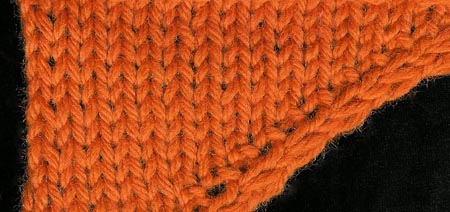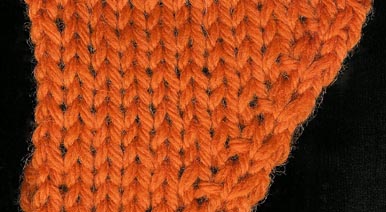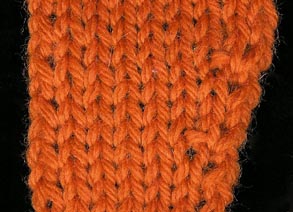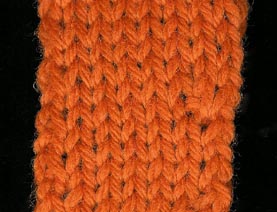11: Shaping
(cont.)
The effect of shaping on edge stitches
Shaping makes an outline, influences the fit of
a garment and adds the visual effect of sequences of holes, sloping
stitches or bars, but it also has another very important effect.
Shaping alters the angle of adjoining stitches by creating a slant,
either towards or away from an increase or decrease.
As the shortest distance between two points is a straight line, a
slant means that a sloped stitch is longer than a right angle
stitch.
If the shaping has been worked some way along a row, the stitches
worked on either side will minimise the effect of the slope, but
when the shaping occurs near an edge, the slope elongates the side
of the stitch at the edge of the row. When there are a sequence of
sloped stitches, as along the edge of a number of rows with a series
of shapings, all the stitches are longer than the stitches where
there are no shapings, and the edges are a right angle. The extra
stitch length can be quite unimportant when shapings are worked many
rows apart, but when the shapings are closer together, the extra
length adds up to a big difference.
The fact that sloped stitches are longer than stitches with a right
angle edge becomes very important when picking up stitches along the
side of a slope. The usual ratio of three stitches being equal to
four rows doesnít apply, because the elongated stitches become
closer in measurement to the normal width of a stitch. Extra
stitches will be needed so that the added knitting or band will fit
correctly to the number of rows. If there are not enough stitches,
an added trim like a neck or a band will gather in the knitting and
make the edge into a bowed shape.
The number of rows between decreases or increases has an influence
on the size of the edge stitches. When the shapings are worked on
every row, the shaping rows are close together. Because the angle of
the slope is very pronounced, the slant of the stitches at the edge
will be longer than ordinary stitches. Remember to knit edge
stitches loosely to allow for the stretch.
If the shapings are worked on every second row, the rows are further
apart, the angle will be less sharp and the stitches will be
slightly shorter.
By the time you are shaping six, eight, ten or more rows apart, the
sloping stitch edge difference to a right angle edge has all but
disappeared [pic 22,23,24,25].

22: A long slanted edge stich formed
by increasing on every row contrasts with the shorter right angle
edge stitches.

23: Because the increases have been
worked on every second row, the slope is less pronounced, and the
stitches are shorter.

24: When the increases are four rows apart, the sloped
edge stitches are only slightly longer than the right angle
stitches.

25: Increases worked six or more rows apart have
little or no influence on the length of the stitches on the sloping
edge.
If itís difficult to see the difference,
measure a length along a sloping side and count the stitches.
Measure the same length against a right angle side of the knitting
and then contrast the stitch count. The greater the slope angle, the
closer the stitch size at the side of the row is to the width of a
stitch. You will need to skip or miss less rows when picking up or
joining stitches to rows.
When a skirt, a sweater or a jacket or any other garment is
increased or decreased at each side so that it is wider at the hem,
the sides will hang in a point. This is because the side seams are
longer than at the measurement on the straight at the centre of the
garment. Shaping has elongated the side stitches. This can be a
wonderful design feature, or a problem. If you want to eliminate the
points, you will have to divide the number of shapings and
distribute them evenly along rows, instead of just increasing or
decreasing at the side of the garment.
Picking up stitches on necklines, around armholes, adding bands or
trims on a slope and attaching added on pieces are all areas where
you will encounter sloping edge stitches. Dealing with them seems
complicated at first sight, and you may think there is too much to
remember, but as you knit and try it out, you will find that there
are really not a lot of variations. It all works like clockwork.
NEXT
CHAPTER >>
chapter page: 1 |
2 | 3 |
4 | 5 | 6 |